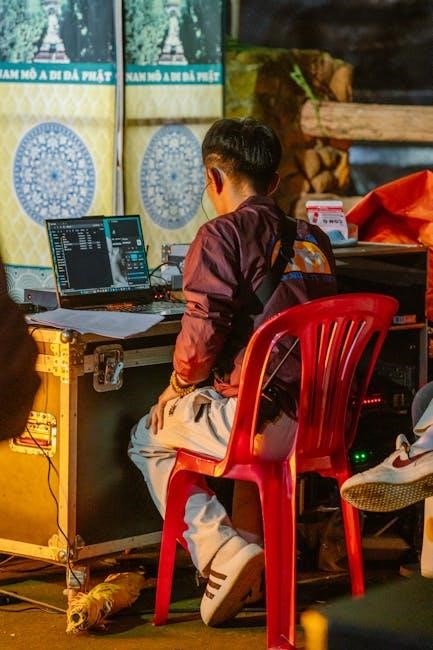Understanding RV wiring is essential for safe and efficient electrical system management․ Proper installation ensures reliability, preventing hazards and optimizing performance for both DC and AC systems․
Understanding the Basics of RV Electrical Systems
RV electrical systems operate on two primary power sources: a 12V DC system and a 120V AC system․ The 12V system, powered by a battery, manages essential functions like lighting, appliances, and electronics․ The 120V AC system, typically connected to an external power source or generator, powers larger appliances such as microwaves and air conditioners․ Both systems must work together seamlessly for optimal performance․ Proper wiring ensures safe and efficient energy distribution, preventing hazards and maintaining reliability․ Understanding these fundamentals is crucial for maintaining and upgrading your RV’s electrical setup effectively․
Importance of Proper Wiring in RVs
Proper wiring is critical for the safety, efficiency, and reliability of your RV’s electrical systems․ Incorrect or poorly installed wiring can lead to electrical hazards, fires, and appliance malfunctions․ It ensures that both 12V DC and 120V AC systems function correctly, powering essential appliances and electronics․ Proper wiring also prevents power surges, overheating, and electrical shocks, safeguarding occupants and equipment․ Additionally, it avoids costly repairs and ensures compliance with safety standards․ Well-planned wiring enhances performance, reduces energy waste, and guarantees a trouble-free RV experience․ Always prioritize professional installation or follow trusted guides to maintain safety and efficiency․

RV Electrical Systems Overview
RVs feature two separate electrical systems: a 12V DC system powered by batteries and a 120V AC system similar to home wiring․ Understanding these systems is crucial for safe and efficient use;
12V DC System Components
The 12V DC system in RVs is powered by a deep-cycle battery or battery bank, providing energy for essential appliances like lights, water pumps, and ventilation fans․ A battery management system regulates charging from solar panels, generators, or shore power․ Circuit breakers or fuses protect against overloads, while a DC distribution panel connects components․ Proper wiring with suitable gauge cables ensures efficient power distribution․ The system is designed for off-grid use, making it ideal for remote camping without external power sources․ Understanding these components is vital for maintaining reliability and safety in the RV’s electrical setup․
120V AC System Components
The 120V AC system in RVs is designed for high-power appliances like microwaves, air conditioners, and refrigerators․ It relies on an external power source, such as shore power or a generator, connected through a 30/50-amp service․ The AC distribution panel houses circuit breakers or fuses to protect against overloads․ Wiring is typically heavier gauge to handle higher currents safely․ Appliances are connected via standard household-style outlets․ A transfer switch ensures seamless switching between power sources․ Proper grounding and GFCI protection are critical for safety․ This system is essential for modern RV comforts, requiring careful installation and maintenance to prevent hazards․
Differences Between AC and DC Power in RVs
RV electrical systems utilize both AC (alternating current) and DC (direct current) power, each serving distinct purposes․ AC power, typically 120V, is used for high-demand appliances like microwaves and air conditioning, requiring an external power source or generator․ DC power, at 12V, powers essential systems like lighting, pumps, and electronics, sourced from the RV’s battery․ AC systems require heavier wiring and circuit protection, while DC systems are simpler with fuses․ Properly integrating both ensures reliable operation of all RV functions, maintaining safety and efficiency for owners․ Understanding these differences is crucial for effective system management and troubleshooting․

Planning Your RV Wiring Layout
Planning your RV wiring layout ensures functionality and safety․ Assess power needs, create a detailed diagram, and select appropriate components for efficient system operation․
Assessing Your RV’s Electrical Needs
Assessing your RV’s electrical needs is crucial for a safe and efficient setup․ Start by evaluating the power requirements of all appliances and devices․ Consider both 12V DC and 120V AC systems, as they serve different purposes․ The 12V system powers essential items like lights and appliances, while the 120V system handles heavier loads via a generator or shore power․ Calculate the total power consumption to avoid overloading the system․ Determine battery capacity based on usage patterns, especially if boondocking․ Also, consider future upgrades, such as solar integration or lithium batteries, to ensure scalability․ This step ensures your wiring layout meets current and future demands․
Creating a Wiring Diagram for Your RV
Creating a wiring diagram for your RV is essential for organizing and understanding its electrical system․ Start by listing all components, including lights, appliances, battery, solar panels, and inverter․ Use standardized symbols for clarity․ Begin with the battery as the 12V power source, connecting to the electrical panel․ Include wire gauges and lengths to ensure safe current flow․ Add fuses and circuit breakers near key junctions for protection․ Integrate solar panels and their controller, ensuring proper connection to the battery․ Consider both 12V and 120V systems, showing interactions like the inverter’s role in converting power․ Use color-coding for wires to simplify tracing connections․ Finally, include grounding wire connections for safety․ This organized approach ensures a clear, functional diagram for your RV’s electrical setup․

Choosing the Right Wiring Components
Choosing the right wiring components for your RV ensures safety and efficiency․ Select appropriate wire gauges, circuit breakers, and connectors for both 12V and 120V systems․ Consider solar and battery connections to optimize performance and prevent hazards․
Types of Wires for RV Electrical Systems

RV electrical systems require specific wire types to ensure safety and efficiency․ For 12V DC systems, use stranded copper wires with insulation rated for higher temperatures․ These wires are ideal for connections between batteries, inverters, and appliances․ For 120V AC systems, use jacketed or sheathed wires with grounding conductors to prevent shocks and short circuits․ Solar installations often require thicker, higher-current wires to minimize voltage drop․ Always select wires that meet RV-specific standards and regulations, ensuring durability and reliability for your electrical setup․ Proper wire selection is crucial for performance and safety in your RV electrical system․
Selecting Circuit Breakers and Fuses
Selecting the right circuit breakers and fuses is crucial for protecting your RV’s electrical system from overcurrent conditions․ Circuit breakers act as the first line of defense, automatically disconnecting power when a fault occurs․ Fuses provide additional protection by melting when excessive current flows․ Choose breakers and fuses with amp ratings that match your system’s maximum current draw․ Consider voltage ratings and compatibility with your RV’s wiring․ Circuit breakers are reusable, while fuses are single-use but cost-effective․ Always consult your RV’s wiring diagram to ensure correct sizing and installation․ Proper selection ensures safety and reliability in your electrical setup․
Understanding Inverter and Charger Requirements
Understanding your RV’s inverter and charger requirements is vital for reliable power management․ Inverters convert 12V DC battery power to 120V AC for appliances, while chargers replenish the battery from an external power source․ Choose an inverter with sufficient wattage to handle your largest AC load, such as a microwave or air conditioner․ Pure sine wave inverters are recommended for sensitive electronics․ Chargers should match your battery type, whether lead-acid or lithium, to ensure proper charging and longevity․ Consider a combined inverter-charger unit for streamlined performance․ Always size your system according to your RV’s energy demands to ensure efficient and safe operation․

Installing the Battery and Electrical Panel
Proper installation of your RV’s battery and electrical panel ensures safe and reliable power distribution․ Start by securing the deep-cycle battery and connecting it to the panel according to manufacturer specifications․
Step-by-Step Guide to Battery Installation
Begin by selecting a suitable location for your RV battery, ensuring it’s secure and protected from moisture․
Next, connect the positive terminal to the electrical panel using heavy-duty cables, avoiding any shorts․
Then, attach the negative terminal to a grounding point, ensuring proper system safety․
Finally, test the connections to confirm they’re functioning correctly․ Always follow safety guidelines to prevent electrical hazards and ensure reliable power supply for your RV systems․
Connecting the Battery to the Electrical Panel
Start by ensuring the battery is fully secured and accessible․
Connect the positive battery terminal to the electrical panel’s designated positive input using appropriately sized wires․
Attach the negative terminal to the panel’s grounding point or chassis, ensuring a clean connection․
Install circuit breakers or fuses between the battery and panel for overload protection․
Double-check all connections for tightness and integrity․
Finally, test the system to confirm proper power distribution to all connected components․

Solar Power Integration
Solar power offers a renewable energy solution for RVs, reducing reliance on batteries․ Install panels, charge controllers, and inverters to harness sunlight efficiently for electrical needs․
Understanding Solar Power Wiring Diagrams

A solar power wiring diagram is a visual guide for installing and connecting solar panels to your RV’s electrical system․ It outlines the components, such as solar panels, charge controllers, and inverters, and shows how they interconnect․ The diagram helps ensure proper installation, safety, and efficiency․ Key elements include battery connections, wiring sizes, and safety features like fuses or circuit breakers․ By following the diagram, you can optimize energy harvesting and integrate solar power seamlessly with your RV’s existing electrical setup․ Properly understanding the diagram is crucial for a reliable and efficient solar power system․
Connecting Solar Panels to Your RV’s Electrical System
Connecting solar panels to your RV involves mounting them securely and wiring them to the electrical system․ Start by installing the panels on the roof, ensuring proper alignment for maximum sunlight exposure․ Next, connect the panels to a solar charge controller, which regulates power flow to the battery․ Use appropriate wiring sizes to minimize voltage drop․ The controller is then connected to the RV’s battery bank, which stores excess energy․ Finally, integrate the system with your inverter for AC power needs․ Always use fuses or circuit breakers to protect the circuit and ensure safe, efficient energy transfer․

Safety Guidelines and Best Practices
Adhere to safety guidelines and regulations when wiring your RV․ Use proper tools and materials, avoid common mistakes, and test the system thoroughly․ Always follow best practices to ensure reliability and prevent hazards․
Regulatory Guidelines for RV Wiring Installations
When installing RV wiring, adhere to regulatory guidelines such as BS 7671 and local electrical codes to ensure safety and compliance․ Proper wiring practices, including the use of approved materials and circuit protection, are essential to prevent hazards․ Always follow manufacturer specifications and consult a licensed electrician for complex setups․ Compliance with these standards ensures your RV’s electrical system operates safely and efficiently, minimizing the risk of electrical fires or system failures․ Regular inspections and updates to meet current regulations are also recommended to maintain reliability and safety over time․
Common Mistakes to Avoid in RV Wiring
Avoid common RV wiring mistakes to ensure safety and reliability․ Using incorrect wire gauges, overloaded circuits, and poor connections are frequent errors that can lead to electrical fires or system failures․ Neglecting proper grounding and ignoring voltage drops can also cause issues․ Overreliance on extension cords and mixing AC and DC systems without proper isolation are additional pitfalls․ Always follow manufacturer specifications and regulatory guidelines to prevent these hazards․ Consulting a professional for complex installations is advisable to avoid costly repairs and ensure compliance with safety standards․ Regular inspections can help identify and correct potential issues early․
Troubleshooting Common Electrical Issues
Troubleshooting RV electrical issues requires a systematic approach․ Start by identifying symptoms like blown fuses, tripped breakers, or dead batteries․ Check connections for looseness or corrosion, as these are common culprits․ Use a multimeter to test voltage and continuity in circuits․ Consult your RV’s wiring diagram to trace power sources․ Addressing issues promptly prevents further damage․ Regular inspections and maintenance can help identify potential problems before they escalate․ Always refer to your system’s manual for specific guidance, and consider professional help for complex faults to ensure safety and reliability․

Advanced RV Wiring Systems
Upgrade your RV’s electrical system with lithium batteries for enhanced performance and longevity․ Consider smart systems for real-time monitoring and efficient energy management, ensuring optimal power distribution and safety․
Installing Lithium Batteries for Improved Performance
Upgrading to lithium batteries enhances your RV’s electrical system with higher energy density and longer lifespan․ Unlike traditional lead-acid batteries, lithium batteries charge faster and maintain consistent power output․ Ensure compatibility by selecting batteries with suitable voltage and capacity for your RV’s needs․ Proper installation involves connecting them to the electrical panel and inverter, following manufacturer guidelines to prevent damage․ Lithium batteries are ideal for solar integration, optimizing energy storage and providing reliable power during off-grid adventures․ Always use appropriate wiring and circuit protection to ensure safety and maximize performance․
Upgrading to a Smart Electrical System
Upgrading to a smart electrical system revolutionizes your RV’s power management․ Modern systems offer real-time monitoring and control via touch-screen panels or smartphone apps, optimizing energy usage and safety․ Key components include advanced battery management, solar integration, and automated circuit protection․ These systems provide detailed diagnostics, reducing the risk of electrical failures․ For example, the Renogy 200ah Lithium setup integrates seamlessly with smart systems, enhancing efficiency․ They also support remote monitoring, ensuring your RV’s electrical health from anywhere․ This upgrade is particularly beneficial for full-time RVers, offering unparalleled convenience and reliability for off-grid adventures․
Proper RV wiring ensures safety and efficiency․ Refer to our recommended tools and guides for a seamless setup․ Always follow best practices for optimal performance․
Final Tips for a Safe and Efficient RV Wiring Setup
To ensure a safe and efficient RV wiring setup, always follow regulatory guidelines and use high-quality components․ Plan your system carefully, considering both 12V DC and 120V AC needs․ Regularly inspect wires for damage and test connections to prevent electrical issues․ Invest in a reliable battery and inverter setup, and consider upgrading to lithium batteries for improved performance․ For solar integration, refer to detailed wiring diagrams to optimize energy efficiency․ Keep essential tools and resources handy, and never hesitate to consult professional guides if unsure․ Proper maintenance will ensure years of trouble-free RV adventures․
Recommended Tools and Resources for RV Wiring
Essential tools for RV wiring include a multimeter for voltage testing, wire strippers, and crimpers for secure connections․ A circuit tester helps identify electrical issues․ For resources, refer to detailed wiring diagrams and guides from trusted sources like Explorist․life or Renogy․ Interactive diagrams provide visual clarity, while step-by-step tutorials simplify complex installations․ Consider investing in a comprehensive wiring guide for advanced setups, ensuring safety and efficiency․ Proper tools and resources are crucial for a successful and reliable RV electrical system․
